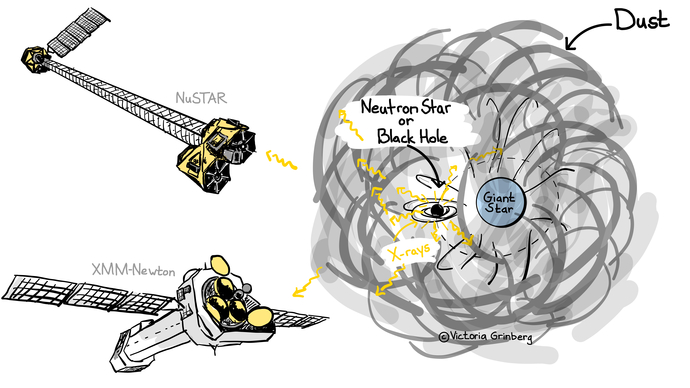NuSTAR | California Institute of Technology | 2020 Sep 15
NASA’s NuSTAR and ESA’s XMM-Newton satellites have observed a young, massive star in close orbit with the compact remnant from a collapsed star, thereby studying how massive stars evolve and interact. The system, named IGR J16318-4848 and situated in one of the spiral arms of the Milky Way Galaxy, is cocooned in a thick shroud of dust. The young supergiant star is feeding material onto the compact object, which is either a neutron star or black hole left over from the explosion of a more massive star. High-mass X-ray binaries, such as this, are strong X-ray sources and constitute a crucial phase in the life of the most massive stars in our universe. During this phase, the companion star primarily loses material through its dense wind. The mass loss both affects the future evolution of the stellar companion itself as well as of the binary system as a whole. As in the case of IGR J16318-4848, the wind material can enshroud the whole system and obscure most of the light it emits. However, such systems are still observable at X-ray wavelengths since X-rays can penetrate even thick material. Observations by X-ray satellites can thereby reveal properties of extreme stellar winds and improve our understanding of how stars evolve.
- Illustration of the IGR J16318-4848 system, as observed by NuSTAR and XMM-Newton. A young, massive star is generating a strong wind, which both feeds the compact companion and enshrouds the whole system in dust and gas. The companion, either a neutron star or black hole, is the remnant of an exploded, more massive star. As the remnant feeds on this stellar wind, a very hot accretion disk forms and generates X-ray emission. Though the dust shroud absorbs most of the lower energy X-rays from this disk, higher energy X-rays escape and are observed by NuSTAR. The absorbed X-rays also cause iron and nickel fluorescence in the dusty shroud, which is primarily observed by XMM-Newton. Credit: Victoria Grinberg
IGR J16318-4848, discovered in 2003 and an enigma ever since, is one of the most obscured X-ray binaries known. It is so heavily absorbed that only the most energetic, most penetrating X-ray light escapes the thick shroud, and the X-ray emission is dominated by strong features associated with fluorescing iron and nickel.
Previous X-ray observations of IGR J16318-4848 by several satellite missions have raised puzzling questions about the absorbing material: What can produce such strong fluorescence lines? Why is the predicted irregular shape of the heavily absorbed iron emission line not observed? Furthermore, an observation of the source with the Japanese Hitomi mission in 2016 found that the absorbing material is not highly ionized. How can this be when the material is being irradiated so intensely from the central source? ...
Dust and Gas Absorption in the High-Mass X-ray Binary IGR J16318-4848 ~ Ralf Ballhausen et al
- Astronomy & Astrophysics 641:A65 (Sep 2020) DOI: 10.1051/0004-6361/202038317
